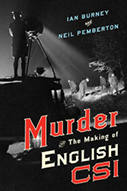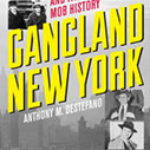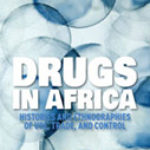Murder And The Making Of English CSI

Authors: Ian Burney and Neil Pemberton
Publisher: Baltimore, MD: Johns Hopkins University Press, 2016. 235p.
Reviewer: Anne Crowther | March 2017
Thanks to ubiquitous television dramas featuring forensic science teams, itis no longer necessary to indicate what the letters “CSI” stand for. But, as Ian Burney and Neil Pemberton point out, crime scene investigation is a relatively new term, probably going back no further than 1946, and reaching the Oxford English Dictionary only in 2010. While the term is comparatively recent, the concept stretches back further — the authors locate its modern origins in the work of the Austrian Hans Gross and his influential handbook on criminal investigation, first published in 1893 and translated into English in 1906. Gross’s immensely detailed work established the character and role of the Investigating Officer responsible for protecting the scene of a crime from contamination, for ensuring that the whole scene was examined meticulously, and for calling in a team of experts, including pathologists, when necessary. Gross’s work was elaborated in the early twentieth century by Edmond Locard in Lyon, whose emphasis on laboratory-based police investigation required “a combination of observational virtuosity and analytical precision rooted in a disciplined deployment of the imagination” (p32). This was seen particularly in his emphasis on dust, for he examined the layers of deposit on shoes or at the crime scene in a manner that drew on new archeological techniques, not seeking for spectacular clues, but undertaking a tedious and methodical sifting through the whole site. All this has moved blithely into the televisual realm, where the viewer has come to expect the encircling “crime scene” tape, the battalions of constables keeping the public at bay, the dedicated search officers, and the instant identification in the laboratory of any suspicious particles.
Burney and Pemberton aim to show how what we now take (often too much) for granted in CSI has developed differentially in time and place, and they concentrate on murder, the best documented of crimes, to support their argument. They give an absorbing account of the very slow reception of Continental views of CSI in the English context. Although we tend to think of ‘forensic science’ as depending on internationally acceptable techniques, the use of these techniques has depended on individual circumstances. In the work of Gross and Locard, the Investigating Officer was not the medical witness, but a dispassionate and careful detective police officer. Locard’s ideal detective openly acknowledged a debt to the most famous fictional model, Sherlock Holmes, whose skill in spotting and classifying material traces such as cigar ash or mud was much respected. Nevertheless, the English approach to CSI was dominated for the first half of the twentieth century by a reliance on the “celebrity pathologist”. The popular press cemented this view of the medical witness as leader of the investigation, who could be trusted not only to conduct an autopsy, but to interpret the crime scene and any other material traces. Nineteenth-century views on social class persisted. After all, the doctor, as an educated man, would always be more intelligent than a lowly police officer, would he not? It might be added that in early British detective fiction, the upper-class private investigator was always ahead of the plodding police.
The authors demonstrate the changing nature of CSI in England through a detailed description of two sensational cases: the murder of Emily Kaye in 1924, and the discovery in 1953 of the bodies of victims of serial murders at 10 Rillington Place, London. In both cases a pathologist played a leading part, but the conduct of the investigations was entirely different. In 1924, Bernard Spilsbury, already much in the public eye as an esteemed forensic specialist, went to the crime scene in a lonely coastal cottage, and had to deal on the spot with a particularly grisly set of dismembered and boiled human remains. In court, he offered an opinion on the defense’s argument for an accidental death, even though the items involved had passed through several hands in a way that would be unacceptable today. Spilsbury was given the lion’s share of credit by a mesmerized press, and subsequent crime writers have accepted that he was the “father” of modern CSI, and the originator of the “murder bag” that police investigators were required to carry. The authors here demonstrate very convincingly that Spilsbury’s reputation is largely undeserved in relation to CSI — he actually visited the scene of a crime in only about ten per cent of recorded cases, and the “murder bag” he suggested consisted of items designed to protect the investigator from infection when handling putrid remains.
By contrast, the successful investigation in 1953 relied not only on the painstaking work of the pathologist Francis Camps, but on the type of teamwork envisaged by Locard. The police, armed with a much more modern “murder bag” for the handling of evidence, conducted an archeological dig (unearthing two more bodies in the process), and Camps himself changed his original view on the cause of death when he received results from the forensic science laboratory. In the intervening years, several English police forces had begun to adopt more Continental approaches to CSI, and local authorities had been persuaded to set up forensic laboratories. Pathologists might also work in an up-to-date mortuary rather than a leaking shed at the back of the police station. The Metropolitan Police, who remained in thrall to the views of celebrity pathologists for some time, were slow to embrace the new techniques of CSI. Throughout the book, the authors discuss the relationship between popular representations of crime, particularly in the press, and the influence these had on the public’s view of CSI.
A book on this subject can hardly fail to interest. The authors rather disarmingly apologize for some of the disturbing contemporary black-and-white photographs, though it is unlikely that a generation weaned on television CSI in colour will be much distressed. One minor cavil is that too much is taken for granted over the degree of background knowledge that the reader might possess. A footnote disclaims any intention to recount the “gothic” details of the crucial cases; but a few sentences to stop the reader from wondering how the police discovered the Kaye murder in the first place, or why a neighbor had decided to put up shelves in the unoccupied 10 Rillington Place, would smooth the course of the narrative. An issue which is obvious from the text, but not clearly discussed, is the different nature of policing and prosecution in England and the Continent. The decentralized nature of English police meant that much remained in the hands of local government in deciding how much time and money to invest in CSI. Gross had a university base for his research, while Locard was a doctor with a public contract. This contrasts with the free-enterprise nature of English forensic pathology, which had a tendency to downgrade teamwork.
Central to Burney and Pemberton’s argument is the contingent nature of CSI, and how far it is affected by social arrangements that are far from scientific. They caution against the tendency to see this story as one of continual progress, ending with the displacement of the traditional CSI by the dramatic intervention of DNA testing, seen as rendering many twentieth-century techniques obsolete. Their book is timely and instructive.
Anne Crowther is Senior Research Fellow in Economic and Social History, University of Glasgow.


